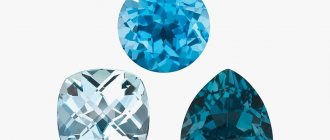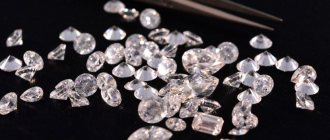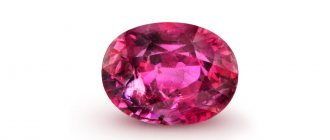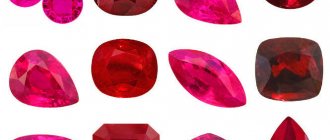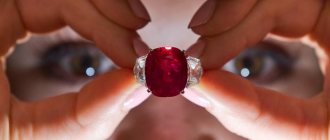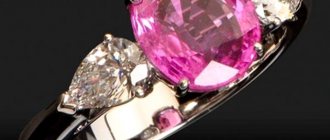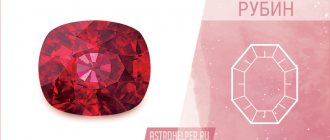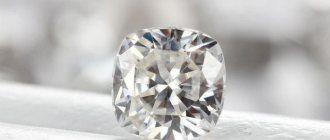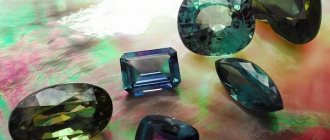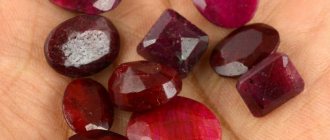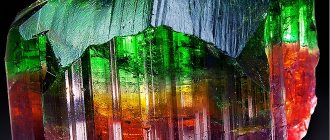How to determine the authenticity of a ruby
A synthetic analogue of a stone is not inferior to a natural one in beauty, attractiveness, and methods of use. And it costs much less. Imitation is simply deception of consumers. We'll tell you how to distinguish a real ruby from a fake.
Check authenticity at home
To check the authenticity of a ruby, it is not necessary to contact the assay office.
Using a magnifying glass
The easiest way to determine the originality of a ruby at home is to carefully examine the stone under a 10x magnification magnifying glass.
- The edges of the artificial stone look fuzzy and blurry.
- If the bubbles in the body of the stone are red, the ruby is real; transparent or absent - artificial.
- Microcracks on synthetics are smooth and shiny; on the gem - zigzag.
A glass counterfeit can be easily detected; distinguishing a natural ruby from an artificial one is more difficult.
With the help of light
Here's how to tell a real ruby from its synthetic counterpart using light.
- In direct sunlight, a natural ruby looks burgundy, while the color of the artificial stone fades.
- In ultraviolet rays, the gem will still glow red, but the synthetic one will begin to glow orange.
- When the stone is rotated in the light, purple tints may appear on the edges. This indicates the natural origin of the mineral. This is what samples of Burmese rubies called “pigeon blood” look like.
Under a magnifying glass, the effect of light on the stone will appear more clearly.
In liquids
In clean water, a reddish glow will emanate from a genuine ruby through the glass walls of the vessel.
Dipped in milk, the gem will turn the white liquid pink. This is an optical effect: the bright color of the ruby, breaking through the polydisperse compound, creates the illusion of coloring. Synthetics and glass are not capable of this.
For strength, weight and heat
Being a super-hard mineral, ruby can scratch glass and metal. Glass imitations are fragile, easily destroyed, and after exposure to them, chips and scratches remain.
The gem is noticeably heavier than a fake of similar weight.
It takes longer to heat up in your hands than the glass imitation.
How to distinguish a genuine ruby from cheaper similar stones
Cheaper gems that resemble red corundum in appearance are sold under the guise of ruby: garnet, tourmaline, spinel.
There are several ways to distinguish a ruby from a garnet.
- The garnet has a weaker shine and does not glow. Rotate the stone in the sun or under an electric lamp. The shine of a ruby is pronounced, similar to diamond, which cannot be said about a garnet.
- The color of garnet is darker than ruby.
- Garnet is magnetized, ruby is not. Place the mineral on the scale and apply the magnet. The weight has decreased - in front of you is a pomegranate.
Tourmaline can be easily identified by turning on an ultraviolet lamp. The red or pink hue of the mineral will change to orange. UV rays will not distort the color of a ruby. Like garnet, tourmaline does not glow.
Semi-precious red spinel is very similar to ruby. It is possible to distinguish between two gems only with the help of a refractometer and a dichroscope.
Ruby is characterized by dichroism - the optical effect of the appearance of a violet tint on red when the lighting changes. Other stones listed do not have this property.
The combination of dust from ruby rocks and glass is difficult to identify. The appearance is practically no different from the original. You have to resort to the services of a gemologist, who will find out how much of the natural component is in the sample.
Lastly (and perhaps first and foremost) is the price. Natural ruby is a gemstone of the first magnitude. The cost of a crystal weighing over a carat is equal to the cost of a diamond. A relatively low price is a sign of synthetics.
The main factors in determining the price of ruby
Significant factors in pricing are:
- Instance weight.
- Corundum color.
- Information about processing to improve the quality of the stone.
- Purity.
- Shape cut and polished.
- Availability of a certificate from a specialized laboratory.
The weight of a ruby increases its value. Moreover, it grows nonlinearly with increasing size.
In terms of spectrum, the most expensive of the large specimens are bright scarlet rubies; they are extremely rare and are often kept in royal treasuries. In Russia, a scarlet Caesar Ruby weighing 250 carats is currently in the Diamond Fund. It, cut in the shape of a bunch of grapes, was presented by King Gustav Adolf to Catherine II in 1777. The price of similar examples “with history” offered at closed auctions from private collections will be simply incredible.
The value of small red specimens has recently declined in part due to the appearance of rubies from Mozambique on the markets.
The most significant of the commercial ones are carmine red jewels in the pigeon's blood . As a rule, these are small stones mined in Burma, near Mogok. Their market value is only growing: alluvial placers are being depleted. Large rubies of this color are quite rare. In the price range, the price for dark red rubies, brownish and rose-red rubies from Tajikistan decreases.
Imitation ruby
Composite stones are considered fake rubies. For example, a thin almandine plate is glued onto red glass. Examining the sample under a magnifying glass will reveal a bond line, or a change in gloss visible from a certain angle at the boundary between glass and garnet. Placing a sample in liquid will also help us find out if it is a fake. The doublet will give itself away as a straight line of connection.
You can distinguish a ruby from glass under a magnifying glass or microscope by gas bubbles and color funnels.
Rhinestones have a single light refraction, and the refractive indices do not correspond to the refraction of the gemstone. But glass can be confused with garnet and spinel based on this indicator.
You can distinguish a real stone from a fake mechanically: by running a file over the stone. A visible mark will remain on the glass or plastic. But what about ruby?
Secondary and indirect factors
Factors that have less influence on the price are the presence of inclusions and information about the ruby deposit . A good specialist may well be able to find out about the origin of a ruby (even taking into account the fact that even stones found nearby can be quite different). Siamese rubies are duller due to the presence of iron, they may contain inclusions in the form of broken thin crystal plates and cavities, while Burmese rubies often contain oriented rutile crystals and hollow channels.
Beautifully arranged rutile needles give Burmese rubies a silky sheen. They will create the effect of a cat's eye in cabochons. And the most valuable asterism is the figure of a pointed star, sliding along the surface of the cabochon as it turns in the so-called star ruby. If the inclusions are minor or have created a beautiful pattern, they will not affect the price, but ideal transparency is a sign of its synthetic origin.
Heat treatment, “healing” cracks and filling cavities reduce the price of the product by half. However, visually such a stone can be simply magnificent. For example, the procedure of filling cracks and cavities with flint glass is also used for star rubies. But it should be borne in mind that stones refined in this way will require special care.
Recently, there has been a tendency to abandon any of these procedures, since defects only emphasize the naturalness of the stone.
It is hardly possible to assess the color of a ruby from a photo; trainings are conducted among novice jewelers on practical assessment of the color of stones. For example, at the Geological Faculty of Moscow State University, where they can also teach you how to distinguish it from red spinel and almandine garnet and talk about methods for determining the dichroism of ruby. GIA color classification system that allows you to navigate the class of ruby by description when choosing an auction.
Synthetic ruby
An artificially produced specimen is called hydrothermal ruby. Synthetic gems are grown from a mixture of chromium, iron and low-quality non-jewelry corundum in special devices under special conditions. The results are complete analogues of natural stones.
An artificial ruby, like a natural one, leaves marks on the glass. The color of both is affected by the amount of chromium in the composition.
Synthetic ruby is perfection itself. Under ideal conditions, a defect-free sample grows. The same cannot be said about natural stones, which have been formed for centuries in an unfavorable (compared to a scientific laboratory) environment. Therefore, they are characterized by certain disadvantages.
Thanks to their correct, uniform structure, synthetic stones are easier to process, more convenient to cut, and flawless in appearance.
The Soviet ruby, a high-quality synthetic stone, is still of particular value.
Mogok ruby weighing 10.1 carats on a diamond brooch from Cartier
$8,428,127 ($834,468 per carat)
Christie's auction, Hong Kong, November 2014
Set with square, triangular and rectangular diamonds, the ethereal octagonal platinum piece is centered on a 10-carat cushion-cut ruby. The piece is accompanied by a report from SSEF confirming the authenticity of the ruby's color. Also included is a letter describing the outstanding characteristics of the stone. Ruby is distinguished by its elegant cut, impeccable clarity and bright, rich color.
Refined rubies
To give a natural mineral greater transparency, enhance color, create or enhance optical effects, rubies are refined. For this use:
- high temperature treatment;
- surface diffusion;
- filling cracks with dyes or a colorless substance;
- foil linings;
- irradiation.
In most cases, rubies become more attractive after refining. Sometimes glass-like particles may appear or defects may expand.
Treated stones are natural, but are valued lower than untreated stones, closer to synthetic ones.
How to grow stone
Synthetic rubies are obtained in several ways.
- The Vernel method is based on the melting of pre-mixed chromium and aluminum trioxide. Single crystals are obtained in the form of a cylinder up to 30 cm long and 2 cm in diameter.
- When using the Czochralski method, crystals are pulled upward from the starting material (seed).
- Zone smelting is the drawing of prepared raw materials along a heating element in a molybdenum container. Ruby in the form of plate-like crystals is formed when the alloy cools slowly.
- Columnar-shaped crystals are obtained by skull melting using high-frequency energy sources.
- In the hydrothermal method, fusible alumina and silica are mixed with chromium compounds, melted, and then placed in an autoclave.
All methods are labor-intensive and expensive.
How to grow a ruby crystal at home
It is impossible to obtain a synthetic ruby crystal without an autoclave, special chemicals and solid knowledge of chemistry and physics. But growing something similar to it is quite possible.
The easiest way is to buy a kit for growing crystals. Next do this:
- pour the powder into a suitable container, pour boiling water over it, stir thoroughly;
- after 2 hours, introduce the seed crystals, close the lid tightly;
- After a day, replace the lid with paper, wait 3-4 weeks.
After this, observe with your own eyes how “ruby” crystals appear.
You can grow an imitation from sugar. Prepare 3 tbsp. sugar, food coloring of a suitable color, 200 ml of water. The algorithm of actions is as follows.
- We dilute sugar with water and cook syrup.
- Add the dye, stir until dissolved, and cool slightly.
- We glue a crystal of granulated sugar to a thread, which, in turn, is tied to cardboard or a pencil to hold the structure at the desired height.
- Place the crystal in the sugar syrup in the center of the glass.
- Cover with paper and wait for crystallization.
In an extremely saturated solution, the sugar crystal will not dissolve, but will grow.
“Synthetic rubies” are grown from table salt in a similar way. You will need: 1 kg of salt, 400 ml of water, dye. We proceed like this:
- Fill a 0.5-liter glass container halfway with salt, add hot water, stir until completely dissolved;
- gradually add salt, stir until the particles no longer disappear from sight;
- add 5-7 packets of food coloring, stir;
- filter the solution into another container;
- we tie or glue a salt crystal to a thread, which we fasten to a pencil;
- lower the crystal into the solution;
- cover the jar with paper.
A red crystal resembling a gem will begin to form around the salt seed.
Such artificially grown rubies are used for their own needs and for sale, but not as jewelry, but as a souvenir.
Approximate ruby price range
- Low quality ruby (low weight, color) from 5,000 to 260,000 rubles. per carat The most expensive are the Burmese ones, and the heated ones are cheaper.
- Good quality from Burma costs 350,000 - 900,000 rubles. per carat, from Mozambique from 150,000 to 600,000 rubles. per carat
- If the quality of the ruby is very good, it can cost from 350,000 to 2,000,000 rubles. per carat
- Excellent quality rubies from Mozambique cost from 700,000 to 1,500,000 rubles. , from Burma 3,000,000 - 5,000,000 rubles. per carat
- If a ruby weighs from 4-5 carats, its cost can reach up to 5,000,000 - 7,000,000 rubles. per carat
Does an artificial mineral have healing and magical properties?
Natural ruby is valued not only for its beauty, but also for its magical properties, including attracting wealth and good luck in love, helping to wisely lead people. The healing effect of the mineral is also high.
Another thing is imitation ruby. There is no magical energy in glass or plastic, in crystals grown from salt or sugar.
The properties of a composite ruby, that is, an alloy of glass and a real ruby component, allow us to talk about its effect on the owner. However, this effect is less pronounced than the influence of a natural gem.
Artificial stone, that is, grown in laboratory conditions, has more modest healing and magical properties. Although disputes on this matter do not stop.
Largest faceted
This title rightfully belongs to Rubin Niilanjali with a double 12-pointed star. Discovered in 1988 and included in the Guinness Book of Records as the largest mineral with two stars. Weight - 274 grams.
The most famous rubies in the world
Queen Elizabeth II Tiara
The ruby tiara was made in 1973 for the Queen of England by her order, and has not yet been worn by anyone else. Elizabeth II provided all the stones for decoration to the jewelers from her own “reserves”. The tiara contains 96 diamonds and many rubies, the number of which, according to the Burmese who gave them, corresponds to the number of diseases that the stones will help cope with. The tiara is made in the form of a magnificent pink wreath (as you know, scarlet roses are one of the symbols of England). Admire this beauty!
Rubin Elizabeth Taylor
The diamond ring with red corundum, given to the actress in 1968 by her husband Richard Burton, weighs 8.24 carats. Before the auction it was valued at $1.5 million and sold for $4.2 million.
Ruby Maniraja
Inserted into a ring in the form of diamond beads in platinum. The weight of the gem is 13.26 carats. He has such outstanding qualities that he is nicknamed the “King of Jewels.” Estimated by experts at $8-10 million, sold at Sotheby’s in 2021 for $10.5 million.
By the way
There are several famous jewels that have gone down in history as rubies, but in reality they are not rubies. The so-called Caesar Ruby is an original crimson-colored stone, shaped like a bunch of grapes, and is actually red tourmaline. The Black Prince's Ruby, or the Bloody Ruby from the Crown of the British Empire - spinel. The Timur Ruby, owned by the Sheikh of Kuwait, also turned out to be a spinel.
The prices for the largest rubies in the world are prohibitive. This is understandable, because the dispute between diamonds and rubies for unsurpassed beauty is often won by red corundums. Unique precious gems are the heritage of humanity, and it would be fair to place them all in national diamond funds for public display.
